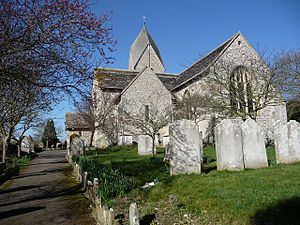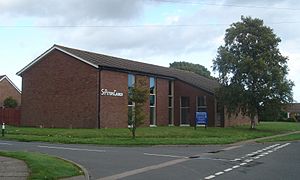Church of St Mary the Blessed Virgin, Sompting facts for kids
Quick facts for kids Church of St Mary the Blessed Virgin |
|
|---|---|

The church from the southeast
|
|
| 50°50′19″N 0°21′06″W / 50.8386°N 0.3518°W | |
| Location | Church Lane, Sompting, West Sussex BN15 0AZ |
| Country | England |
| Denomination | Church of England |
| Churchmanship | Anglo-Catholic |
| Website | https://www.chalkspringchurches.org/st-mary-the-virgin |
| History | |
| Status | Parish church |
| Founded | 11th century |
| Dedication | Virgin Mary |
| Dedicated | By 1442 |
| Architecture | |
| Functional status | Active |
| Heritage designation | Grade I |
| Designated | 12 October 1954 |
| Style | Anglo-Saxon; Norman |
| Completed | 11th century |
| Administration | |
| Parish | South Lancing and Sompting |
| Deanery | Rural Deanery of Worthing |
| Archdeaconry | Chichester |
| Diocese | Diocese of Chichester |
The Church of St Mary the Blessed Virgin is a very old church in Sompting, West Sussex. People also call it St Mary the Virgin Church or St Mary's Church. It's a Church of England parish church. It stands on a quiet lane, surrounded by modern buildings. Much of the church was built in the 11th and 12th centuries.
Its most special part is the Saxon tower. This tower has a unique roof called a Rhenish helm. This is a four-sided, pyramid-shaped roof with gables, which is very rare in England. Because of its amazing architecture and long history, English Heritage has given the church a Grade I listing. This means it's a building of great national importance.
Contents
A Look Back in Time: The Church's History
People have lived in the Sompting area for a very long time. They were here during the Bronze Age, Iron Age, and Roman times. By the 11th century, there were two main villages: Sompting and Cokeham. Both were owned by William de Braose, 1st Lord of Bramber in 1086, as recorded in the Domesday Book.
There was a church on this spot even before the 11th century. Some parts of that first church are still there today. In 1154, William de Braose's grandson gave the church to the Knights Templar. This was a group of religious knights. They made many big changes to the church. They made the nave (the main part of the church) and the chancel (the area around the altar) wider. They made them the same width as the old Saxon tower.
Around 1180, the Knights Templar built a large chapel. This chapel was almost like a separate church. Later, in the 1800s, it was connected to the main church and became the south transept (a part that sticks out like an arm of a cross). At the same time, they added a north transept with an aisle and two smaller chapels.
Changes Over the Centuries
After the Knights Templar became less powerful in 1307, the church was given to another religious group, the Knights Hospitaller, in 1324. They added a chapel on the northwest side of the nave. They also built a porch on the south side and worked on the nave walls. The Knights Hospitaller were later re-established as the Venerable Order of Saint John and started the St. John Ambulance organization.
In the 1700s, the church started to fall apart. Sompting was a small village then, and there wasn't much money for repairs. They even had to sell two church bells in 1791 to pay for important fixes.
In 1853, a man named Richard Cromwell Carpenter led a big restoration project. They put a new roof on the church and replaced the shingles on the spire. The Knights Templars' chapel was rebuilt into the south transept. The stonework was cleaned, and the aisle in the north transept was improved.
The church tower is very special. It's famous for its Saxon design. The unique spire, called a Rhenish helm, is the only one of its kind in England. It looks like a pyramid made of four steep, shingled gables.
Inside and Out: The Church's Design
The church is built mostly from flint stones. It has special Caen stone details and a slate roof. The tower, at the west end, even has some old Roman bricks in it. It was built in two parts and looked as it does now by the end of the 11th century. The tower has stone pilasters (flat columns) at its corners. The arch inside the tower is from the Saxon period.
The nave and chancel are one big open space, without a dividing arch. They were made wider in the 12th century. The north transept has an aisle with two sections and beautiful rib vaulting (arched ceilings). It also has small decorative carvings called bosses. The south transept, which used to be the Knights Templars' chapel, is connected to the main church by an arch from the 1800s.
You can still see old Saxon and Norman carvings in the church. In the south transept, near the 12th-century font, there's a well-preserved carving of an abbot. There's also a 13th-century carving of Christ in Majesty that includes older stone designs. Some decorative carvings are visible on the chancel wall.
St Mary's Church Today
The Church of St Mary the Blessed Virgin was listed as a Grade I building by English Heritage on October 12, 1954. This means it's considered very important and special. As of February 2001, it was one of seven Grade I listed buildings in the Adur district. A famous headmistress from Sompting, Harriet Finlay-Johnson, known for her new teaching ideas, was buried in the churchyard in 1956.
The church's parish covers Sompting village and the nearby urban areas. It also stretches north towards the South Downs. The parish is quite large, covering about 2,507 acres. St Peter the Apostle's Church, a modern brick building in Lower Cokeham, is also part of this parish. It was built in 1966 and is used for both worship and community events.
Today, St Mary's has a Mass with Hymns on the third Sunday of each month at 9 AM. On any fifth Sundays of the month, there is a Choral Evensong at 5 PM. The church is open for visitors on Tuesday mornings. They also celebrate their Patronal festival every August. St Peter's Church in Bowness Avenue, Sompting, has a Mass with Hymns at 9 AM on the first, second, and fourth Sundays of the month.
See also
- List of places of worship in Adur
- List of works by R. C. Carpenter





